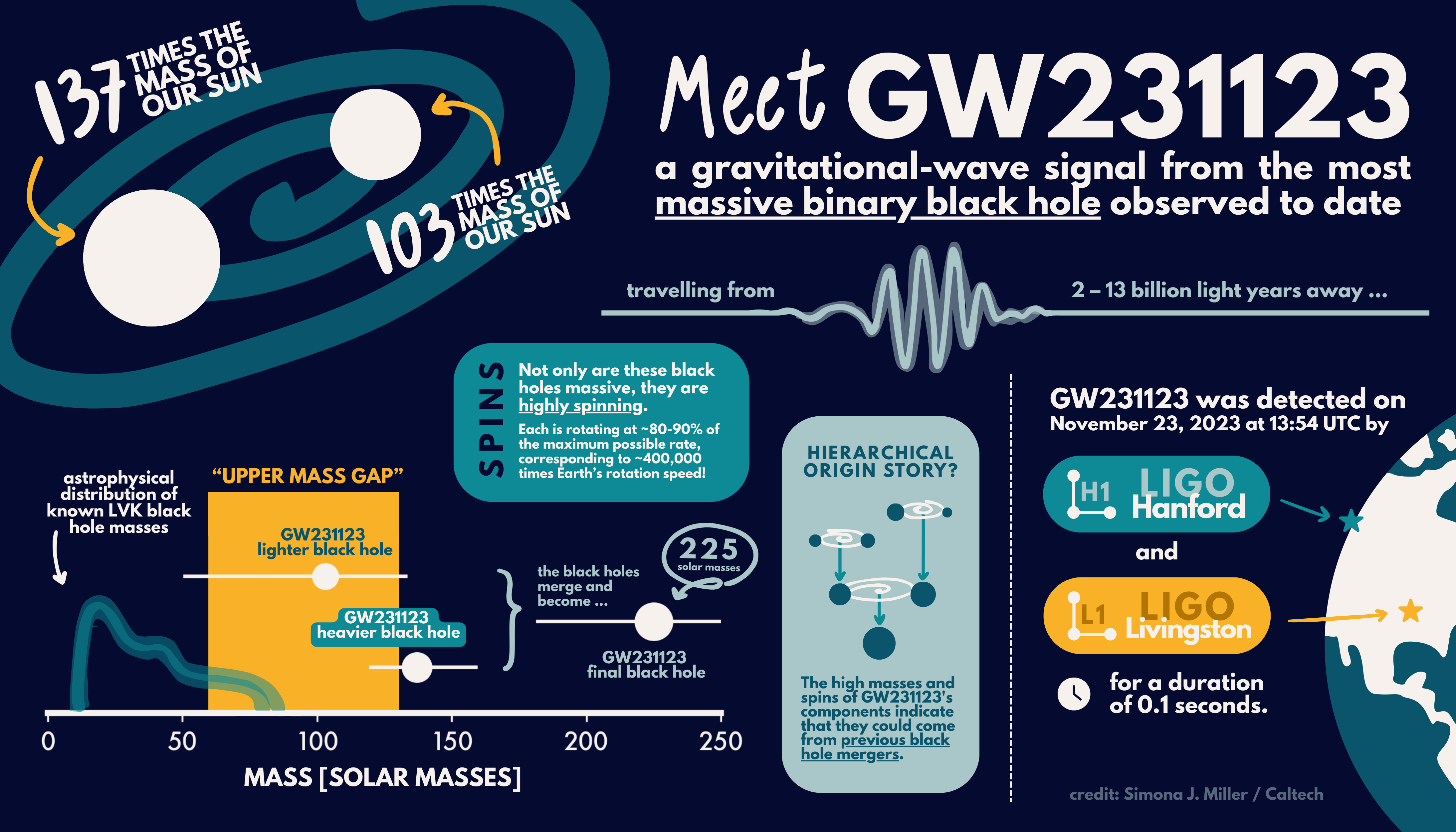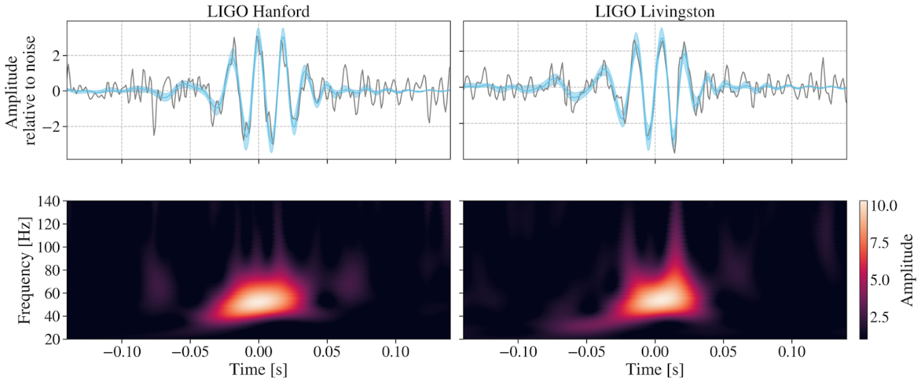
Credits: Simona J. Miller / California Institute of Technology
On November 23, 2023, at 13:54:30 UTC, the LIGO-Virgo-KAGRA (LVK) collaboration detected GW231123, a gravitational-wave signal likely caused by the merger of two black holes with the highest combined mass the LVK collaboration has ever observed. These black holes would have been spinning incredibly fast, and their individual masses appear to fall into a range that challenges existing theories about how massive stars evolve and end their lives.
GW231123 detection paper is available here
DETECTING THE SIGNAL
This gravitational wave was observed by the two Advanced LIGO detectors in Hanford and Livingston during the first part of the fourth LVK observing run (O4a). As shown in Figure 1, the signal lasted about a tenth of a second but stood out clearly, about 20 times louder than the typical detector noise. To ensure this was not a random blip in the data, we performed careful statistical checks. Using techniques that simulate thousands of years’ worth of fake data, we found that the probability of random noise mimicking GW231123 is less than once in 10,000 years! This gives us extreme confidence in the non-terrestrial origin of the signal, and thus in the reality of this gravitational-wave signal.

Figure 1: GW231123 signal in data from the LIGO Hanford (left) and Livingston (right) detectors. The top panels show the amplitude of the data over time (grey traces). The shaded blue band shows our estimate of the true signal. The bottom panels are spectrograms, also known as time-frequency maps, which show the signal amplitude over time (horizontal axis) and across frequencies (vertical axis). Brighter colors represent a stronger signal.
THE SOURCE BEHIND THE SIGNAL
The data strongly suggest that this signal came from the violent merger of two black holes. To learn more about these black holes—like how massive they were and how fast they were spinning—we used several models based on Einstein’s theory of general relativity to simulate what such a signal would look like for different black hole pairs.
By comparing the data to these models, we found that these black holes weighed approximately 137 and 103 times the mass of the Sun, respectively. Taking all uncertainties into account, their total mass was likely between 190 and 265 solar masses, dethroning GW190521 as the most massive black hole binary observed so far. As if that weren’t impressive enough, both black holes were likely spinning almost as fast as black holes can theoretically spin, making GW231123 not just the most massive but also the fastest-spinning black hole binary confidently detected with gravitational waves yet.
The merger produced a black hole with a mass likely between 182 and 251 solar masses. This puts it in a rare category of black holes called intermediate-mass black holes—heavier than those formed from stellar collapse, but much lighter than the supermassive black holes that lurk in the centers of galaxies. The merger remnants of GW231123 and GW190521 stand out as the clearest gravitational-wave detections of these elusive, medium-sized black holes.
WHY ARE THESE PROPERTIES SO INTERESTING?
Current theories on stellar evolution suggest that black holes with masses between approximately 60 and 130 solar masses should be rare or nonexistent. This “forbidden” mass range, known as the black hole mass gap, is thought to result from special types of explosions that either tear heavy stars apart (pair-instability supernovae) or eject a significant portion of their mass before collapse (pulsational pair-instability supernovae), preventing the formation of a heavy black hole.
However, GW231123 challenges this expectation. The lighter black hole is almost certainly within the mass gap, with an 83% chance of falling inside it, while the heavier black hole has a 26% chance. This suggests that traditional stellar evolution might not fully explain their origins.
One tantalizing possibility is that one or both of these black holes may have formed as a result of previous black hole mergers. This would explain their high estimated masses and spins, and would suggest that they lived in an extremely dense astrophysical environment, such as a nuclear star cluster or an active galactic nucleus, where black holes are more likely to collide. These dense environments can also lead to black holes orbiting each other in more elongated or eccentric paths. However, to limit their complexity, our models currently assume that black holes spiral inward in nearly spherical orbits that gradually shrink as they emit gravitational waves. But if the orbits are highly eccentric, especially just before merging, it could affect the emitted waveforms in ways our models do not capture. For GW231123, this possibility remains open and requires more advanced models to test.
Alternative scenarios that may have produced a signal like this one, such as gravitational lensing, primordial black holes, core-collapse supernovae, boson star mergers, and cosmic strings, are astrophysically less likely than the ones discussed above.
THE FINAL MOMENTS OF THE MERGER
For most black-hole mergers that the LVK observes—close to 300 at the time this science summary was written—the detectors are most sensitive to the earlier parts of the signal, when the black holes spiral into each other and eventually merge. However, owing to its large mass, GW231123 provided us with the clearest view of its grand finale: the merger and the ringdown phase, when the newly formed black hole radiates energy through gravitational waves, vibrating and finally settling into a stable state, much like a bell ringing down to silence.
We compared this final portion of the signal to the predictions of general relativity for how a black hole rings down, and found strong agreement between the theory and our data. However, the extreme properties of GW231123 push our models to their limits, leaving some subtle features unexplained and pointing to areas where our waveforms can be improved.
CONCLUSION
A few years ago, in our summary of GW190521, we said that records are meant to be broken, and GW231123 has done just that. With properties that may include black holes in the mass gap and spins near the theoretical limit, this event stands out as both extraordinary and puzzling to interpret. It compels us to explore alternative pathways for black hole formation beyond traditional stellar evolution alone, and brings to light the limitations of our current waveform models. As we continue to listen to the universe through gravitational waves, GW231123 is a potent reminder that the cosmos still holds many surprises, and we are only just beginning to uncover them.
